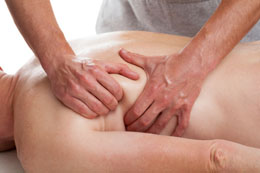A frozen shoulder is an extremely painful condition. Right from pain killers to surgery, there are varied treatment options available for this condition. If you are suffering from a frozen or stiff shoulder, browse through various treatment methods given in the following Buzzle article.

Frozen shoulder, medically known as
adhesive capsulitis is a painful condition characterized by loss of motion, sharp pain across the shoulder blade and/or stiffness in the shoulder. For extreme cases, the name of the condition stands absolutely true; frozen or absolutely no movement. It is a common complaint among individuals of both genders between the age of 40 and 60 years, irrespective of their profession or activities. Frozen shoulder occurs, when the connective tissue surrounding the joint of the shoulder grows together, more like, being stuck together like a band of tissue (adhesions) leading to inflammation and stiffness. This condition, not only causes chronic pain, but also restricts motion greatly, making even simple task sound herculean. There are a number of treatment options available, that one can undergo to ease the pain and stiffness, and increase mobility.
Treatment Options Available
The exact cause of the thickening and contraction of the capsule (connective tissues) surrounding the shoulder joint is not known. It could be a result of an injury or immobility for a long duration. Diabetics are more susceptible to this condition. Diagnosis is based on the individual's physical state and symptoms. In most cases, the physician recommends an X-ray or MRI (Magnetic Resonance Imaging) for ascertaining the severity and ruling out other complications associated with shoulder pain and connective tissues.
Medication: Treatment begins with prescription of pain killers and non-steroidal anti-inflammatory drugs (NSAIDs), such as, paracetamol, ibuprofen, diclofenac, naproxen, etc. These drugs work towards relaxing the tissues by reducing inflammation and easing pain. Steroidal injection into, or near the shoulder joint is given, if the medication does not help and pain does not subside over several weeks. Injection works only as a temporary pain reliever, as the painful symptoms return, once the effect of the medication wears off.
Physiotherapy and Shoulder Exercises: Basic exercise and other forms of physical therapy are used to restore motion. Depending upon the severity, exercises can be a part of home treatment, or would require a dedicated hour or so, under the supervision of a physical therapist. Most shoulder exercises include stretching or motion to loosen up the stiffness. Physical exercises have to be performed regularly to keep the shoulder from further stiffening.
It is important to note that, physiotherapy and shoulder exercises do not heal the frozen shoulder nor cure it, they only help to minimize stiffness. However, on a few bad days, especially during winters, a small amount of stiffness remains. Physiotherapist, at times, uses Transcutaneous Electrical Nerve Stimulation (TENS) to reduce pain, by blocking nerve impulses.
Massage and Other Treatment Methods: Massage done only under supervision, by a qualified individual, may help to reduce inflammation and increase mobility. This treatment also involves use of hot and cold compress, on a daily basis, after some shoulder stretching exercises. Water therapy, which includes exercises performed in water, may also be recommended.
Surgery: Surgery is usually the last resort and meant for cases that cannot be managed with medication and therapy. Surgery involves manipulation of the shoulder under general anesthesia. Manipulation is done by moving the shoulder and arm in such a manner, that it forces the adhesions to break. Another method uses shoulder arthroscopy, wherein, the surgeon cuts the adhesions through the tight portions of the joint capsule.
Irrespective of surgery or no surgery, treatment involves physical therapy to ease stiffness and pain in the shoulder. There is plenty of emphasis laid on early diagnosis and treatment, where exercising the ligaments and tendons is involved, so as the adhesions are not formed.


 Frozen shoulder, medically known as adhesive capsulitis is a painful condition characterized by loss of motion, sharp pain across the shoulder blade and/or stiffness in the shoulder. For extreme cases, the name of the condition stands absolutely true; frozen or absolutely no movement. It is a common complaint among individuals of both genders between the age of 40 and 60 years, irrespective of their profession or activities. Frozen shoulder occurs, when the connective tissue surrounding the joint of the shoulder grows together, more like, being stuck together like a band of tissue (adhesions) leading to inflammation and stiffness. This condition, not only causes chronic pain, but also restricts motion greatly, making even simple task sound herculean. There are a number of treatment options available, that one can undergo to ease the pain and stiffness, and increase mobility.
Frozen shoulder, medically known as adhesive capsulitis is a painful condition characterized by loss of motion, sharp pain across the shoulder blade and/or stiffness in the shoulder. For extreme cases, the name of the condition stands absolutely true; frozen or absolutely no movement. It is a common complaint among individuals of both genders between the age of 40 and 60 years, irrespective of their profession or activities. Frozen shoulder occurs, when the connective tissue surrounding the joint of the shoulder grows together, more like, being stuck together like a band of tissue (adhesions) leading to inflammation and stiffness. This condition, not only causes chronic pain, but also restricts motion greatly, making even simple task sound herculean. There are a number of treatment options available, that one can undergo to ease the pain and stiffness, and increase mobility.